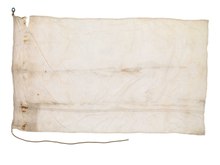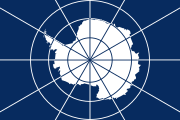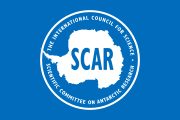User:NotAWittyFish/sandbox1
A flag of Antarctica is a flag or flag design that represents the continent of Antarctica. True South is considered to be the official flag of Antarctica and is the only one recognized Antarctic Treaty members.[1]
Design[edit]
True South is divided into two stripes of navy and white, charged with a counterchanged lozenge. The dividing line between the lozenge is angled down to form a slight "V" shape. The navy and white stripes represent the polar nights and days respectively. The white triangle represents Antarctica's mountains, icebergs, and pressure ridges and the blue point below it represents a southern compass arrow. The diamond shape together represents "the hope that Antarctica will continue to be a center of peace, discovery, and cooperation for generations to come."[2] The color blue on the flag is different from the color of blue on any other national flag, representing its international neutrality.[3] The flag is named after geographic South, or "true South", which differs from magnetic south.[3]
| Blue | White | |
|---|---|---|
| RGB | 27/47/76
|
255/255/255
|
| Hexadecimal | #1b2f4c
|
#FFFFFF
|
| CMYK | 64/38/0/70
|
0/0/0/0
|

History[edit]
BANZARE flag[edit]

The British Australian (and) New Zealand Antarctic Research Expedition (BANZARE) flew an all-white flag from their ship Discovery when sailing to Antarctica in 1929. It was an improvised courtesy flag for Antarctica, but was not proposed represent the continent.[4] The flag was flown only twice.[5] It now resides in the Royal Museums Greenwich.
Proposals from vexillologists[edit]

In 1978, vexillologist Whitney Smith presented an Antarctica flag at an annual meeting of the North American Vexillological Association (NAVA). It is an orange flag with the letter A for Antarctica, a semi-sphere representing the area below the Antarctic Circle, and hands representing human protection of the environment.[6] He chose international orange orange for its visibility.[7]
Graham Bartram, the chief vexillologist of British organization Flag Institute, designed another proposal in 1996 for a computer program.[7] Using the flag of the United Nations as his model, he chose a plain white map of the continent on a blue background symbolizes neutrality. Ted Kaye, a fellow vexillologist and a member of NAVA, had Bartram's design printed and took them with him on an Antarctic cruise. On this trip, it flew at the Brazilian base Comandante Ferraz and the British museum at Port Lockroy.[7]
In 2015, when the "Flag for Antarctica" was added to the emoji keyboard, Bartram's design was used. The design is still used on most supported platforms.[8]
True south[edit]

The True South proposal was designed by Evan Townsend while was living in Antarctica during the winter of 2018.[9][10] Townsend sewed the first version of the design using scraps of canvas fabric from his research station.[11] The flag quickly gained popularity after its introduction.[12] It has flown at research stations across Antarctica[13] and is used by people in countries around the world.[10]
Adoption[edit]
It was adopted by governments, national Antarctic programs, nonprofits, and other organizations as part of an international effort to promote cooperation and conservation for the continent.[14][15]
Flags of territorial claims[edit]

Seven countries have made territorial claims to Antarctica. Australia, New Zealand, and Norway all use their national flag to represent their claim, while Argentina, Chile, France, and the United Kingdom have separate flags for their territorial claims.
| Claim | Flag | Claimant | Use |
|---|---|---|---|
| Adélie Land |  |
Flag of the overseas territory which the claim is a part of | |
| Argentine Antarctica |  |
Flag of the national province which the claim is a part of | |
| Australian Antarctic Territory |  |
Flag of the claimant country | |
| British Antarctic Territory |  |
Flag of the claim | |
| Chilean Antarctic Territory |  |
Flag of the national province which the claim is a part of | |
| Peter I Island |  |
Flag of the claimant country | |
| Queen Maud Land |  |
Flag of the claimant country | |
| Ross Dependency |  |
Flag of the claimant country |
Flags of international Antarctic organizations[edit]
In 2002, members adopted a logo to represent two of the organizations responsible for the administration of the Antarctic Treaty: the Antarctic Treaty Consultative Members and the Antarctic Treaty Secretariat.[16] It is referred to as the "Emblem of the Antarctic Treaty" and is sometimes rendered in the style of a flag. Antarctic Treaty members used the emblem for at least 30 years prior to its formal adoption, having used it on a 1971 commemorative stamp.[17]
Similarly, the Scientific Committee on Antarctic Research (SCAR), a body of the International Science Council, sometimes uses its logo in the form of the flag.[18] In addition to changing its proportions like the emblem of the Antarctic Treaty, SCAR's flag uses inverted colors and an additional circle around the logo.
-
Emblem of the Antarctic Treaty
-
Emblem of the Antarctic Treaty in the proportions of a flag (2:3)
-
Flag of the Scientific Committee on Antarctic Research
See also[edit]
References[edit]
- ^ "Who Owns Antarctica? [Nobody - So, Who Makes the Rules?]". polarguidebook.com. 2022-03-30. Retrieved 2022-10-21.
- ^ "TRUE SOUTH | A New Flag of Antarctica". True South. Retrieved 2020-12-07.
- ^ a b CNN, By Lilit Marcus. "Is Antarctica a country? The future of the world's least understood continent". CNN. Retrieved 2022-08-09.
{{cite web}}:|last=has generic name (help) - ^ "White Flag of Antarctica - National Maritime Museum". collections.rmg.co.uk. Retrieved 2020-10-26.
- ^ Savours, Ann (2013-04-04). The Voyages of the Discovery: An Illustrated History of Scott's Ship. Seaforth Publishing. ISBN 978-1-84832-702-3.
- ^ "Antarctica — Whitney Smith proposal". www.crwflags.com. Retrieved 2022-10-21.
- ^ a b c Kaye, Edward (July 27, 2003). "Flags Over Antarctica" (PDF). Proceedings of the International Congress of Vexillology. XX: 389–401 – via Nordic Flag Society.
- ^ "Flag for Antarctica Emoji". Emojipedia. Retrieved December 13, 2017.
- ^ "Antarctica's first flag gives the uninhabited continent a voice in the climate crisis". 29 April 2021.
- ^ a b "True South: A New Flag for a Global Antarctica".
- ^ "Flag Days: Good Luck, True South". 99% Invisible. Retrieved 2022-10-21.
- ^ "Antarctica", The World Factbook, Central Intelligence Agency, 2022-08-02, retrieved 2022-08-20
- ^ * "Antarctica's New Flag Hopes To Bring Attention To This Fragile Continent". Matador Network. Retrieved 2022-08-09.
- "Flag Days: Good Luck, True South". 99% Invisible. Retrieved 2022-08-08.
- "Antarctica's first flag gives the uninhabited continent a voice in the climate crisis". Dezeen. 2021-04-29. Retrieved 2022-08-09.
- Team, True South (2020-12-04). "True South Flies on All 7 Continents in Celebration of Antarctica Day". True South. Retrieved 2021-01-28.
- ^ Long, Molly (2021-04-20). "This flag has been designed to represent and protect Antarctica". Design Week. Retrieved 2022-08-09.
- ^ Sandigliano, Teo (2021-04-23). "TRUE SOUTH, a new flag for Antarctica's conservation". WeVux. Retrieved 2022-08-20.
- ^ "Antarctic Treaty database - Decision 2 (2002) - ATCM XXV - CEP V, Warsaw". ats.aq. Retrieved 2020-10-26.
- ^ "Postage stamp issues to commemorate the tenth anniversary of the Antarctic Treaty, 1961". Polar Record. 16 (100): 104–105. January 1972. doi:10.1017/S0032247400062677. ISSN 1475-3057. S2CID 251050011.
- ^ Scientific Committee on Antarctic Research (25 February 2013). "Scientific Committee on Antarctic Research (SCAR) Facebook". www.facebook.com. Retrieved 2022-10-21.








